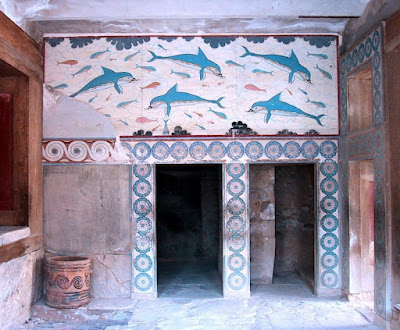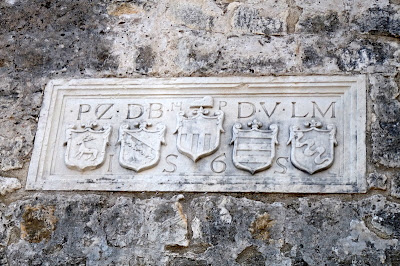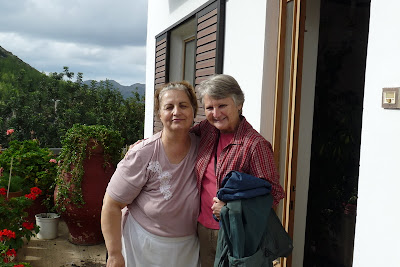Crete is the largest and most southern of the Greek islands and a wonderful escape from the big city of Athens. Crete is best known as the home of the Minoans, a Bronze Age civilization that arose here and flourished from about the 27th century BC to the 15th century BC. It was rediscovered at the beginning of the 20th century and is widely recognized as Europe's first advanced civilization.
The largest and most elaborate of Minoan sites on the island is Knossos. Today, the Palace of Knossos is one of the great archeological sites of the world, yet until Arthur Evans began excavating here in 1900, little was known about the ancient people who inhabited it. Using every possible clue and remnant, Evans rebuilt large parts of the palace - walls, floors, stairs, windows, and columns. This drawing shows how the palace would look if it were fully reconsturcted. It's only partly rebuilt and it's still a labyrinth as far as we could tell. We were extremely fortunate to have a superior local guide to show us around - she made these rocks and ruins come to life!
This was not a palace in the modern sense of a royal residence, but a combination of that and the Minoans' chief religious-ceremonial center as well as their administrative headquarters and royal workshops. The structure was multi-storied, with interior and exterior staircases, light wells, massive columns, storage magazines and courtyards. It looks more like Frank Lloyd Wright than something built of stone and wood over 3000 years ago.

Here are two views of the throne room. This throne doesn't look all that comfortable, but the walls are magnificent.
This dolphin mural is located in the residential part of the palace. This room is thought to have been part of the king's apartment.
In lower sections of the palace (sometimes under a stone floor), there were huge storage areas filled with jugs used as storage containers. Some of them were quite large, making you wonder who lugged them up and down the stairs.
There is a great deal of beautiful pottery in and around Knossos. Most pieces have broken with the passage of 3,000 years, but a few of those found underground are largely intact. We asked about the need to protect these pieces from the weather, etc - our guides said not to worry, there was plenty of this stuff around. Geez.

The Minoans had a sophisticated water and sewer system. Here is part of the water system that channeled drinking water from a source in the vicinity of the palace. The conduit was a series of clay pipes with one end narrower than the other so they could fit together, thereby increasing the water pressure and allowing the water to flow more easily.
The palace contained many frescoes that have been reproduced here - in whole or in part. This was not a drab stone palace like we've been seeing for the past couple of weeks






Near the palace, there is a large flat area surrounded by shallow steps - Arthur Evans called this the 'theater,' since it reminded him of a stage and seats. Further research suggests that viewers (or listeners) were standing, not sitting - this was probably a place for public meetings and debate.
From the theater, a long narrow road leads to the town, past the homes of artisans and others who may have worked in the palace. The road leads on to another complex, not yet fully excavated, but for us it led to the parking lot and back to the city.
After exploring the huge palace complex, we went to the Archeological Museum in Crete's capital city, Heraklion. This museum is the world's premier collection of art and artifacts from the Minoan civilization - thankfully, these treasures have remained on Crete instead of being carted off to other museums around the world.
Again, our guide made all the difference. She led us through the exhibit, explaining what we were seeing and reminding us what we saw at the archeological site. It is truly amazing what a difference it makes to see the archeological site first - sure was nice to have some perspective about where all this 'stuff' came from. Some highlights:
Carved animal figures, including a bowl containing a herd of sheep and a shepherd.


The golden bee pendant - two bees are placing a drop of honey in a honeycomb that they hold between their legs; on their heads is a wire cage with a gold globule inside. Dated about 1800 B.C.
The phaistos disc - a clay disc with impressions on both sides of hieroglyphic symbols arranged in a spiral running from the edge of the disc to the center.
Around the corner from the museum is a shady square that leads to St. George's Gate, an ancient opening in the old city walls. It has been used since Venetian times as a passage between the city and the port - today it is all that remains of an important medieval entrance to the city.
On the city wall near the gate, there is a plaque dated 1565, with the coats of arms and initials of the leading Venetian families of the time.
The great Venetian Walls and bastions were part of the fortress-city the Venetians called Candia. Two of the great city gates have survived fairly well. The Chania Gate (dating from about 1570) was at the western edge of the city. The Gate of Gesu (about 1587) is at the southern edge. The city walls, built by forced labor of Cretans, are among the longest in all of Europe - nearly three miles around the Old Town. We walked around most of this distance - an interesting way to get an overview, literally.
The port of Heraklion is busy with ferries and cruise ships (thankfully we're here in the off-season), but there are lots of pleasure boats and colorful fishing boats as well. Even on a Sunday morning, there are fishermen cleaning their nets or just arguing about politics or just fiddling with their worry beads.

The whole area is dominated by the Venetian fortress at the harbor gate. The fortress was built by the Venetians around 1530; for centuries it was used as protection against invaders, as were the city walls and moats. Although greatly restored, it is essentially the Venetian original. It is notable for its thick walls, spacious chambers, great ramparts, cannons, and Lion of St. Mark plaques.
From the fortress, looking back toward the city we could see the huge arches that were part of the Venetian Arsenals, where guns and gunpowder were stored and ships were built and repaired - the sea at that time came much farther than it does now. The greatest threat of invasion came from the seaward side of the city and many naval skirmishes were fought off this coast.
Directly opposite the old harbor is the car-free 25 August Street, which was named for the beginning of the revolution which led to the declaration of an independent Cretan State, and ultimately unification with Greece in 1913.
The Venetian Loggia, now reconstructed, dates from the early 1600s. Prominent Venetians once met here to conduct business affairs; it now houses city government houses.
The Venetian Loggia, now reconstructed, dates from the early 1600s. Prominent Venetians once met here to conduct business affairs; it now houses city government houses.
Fountain Square (also known as Lions Square) is the home of a fountain installed here in 1628 by Crete's Venetian governor. It's the heart of Heraklion and definitely the place to see and be seen. It's also the best place to try 'bougatsa,' a vanilla cream-filled pastry that is sinful but delicious.
St. Mark's Basilica at Fountain Square was built in 1239 and has been restored to its 14th-century Italian style. It is used for exhibitions and concerts and is the home of native son El Greco's painting, "The Baptism of Christ."
Not far from the square is the Agora - the Market Street that is the place to find anything and everything from socks to shirts to herbs, fish and fresh meat. Side streets lead to small restaurants and shops - you could spend days here...
At the upper end of the market, Kornarou Square has a lovely Turkish fountain and the Venetian Bembo Fountain that features a headless statue (1588). The shop here serves Greek coffee and aperitifs from an antique stone pavilion, a reminder of Crete's Turkish past. It seems to be a favorite hangout for men who like to drink strong coffee and argue local politics.
Cathedral of Ayios Minas (St. Minas) was built in the 19th century, dedicated to the patron saint of Iraklion. It is one of Greece's largest churches, completed in cruciform shape with twin towers. Here we were introduced to little votive medallions, hung in the church as prayers for health or as thanks for good health.
Church of Agios Titos is dedicated to the patron saint of Crete, who introduced Christianity to Crete. Saint Titus was a fellow traveler of St. Paul; he preached the gospel in Crete during Roman rule and was martyred for his efforts.
Church of St. Katherine was built in the 15th century. During the 16th and 17th centuries, this church hosted a monastery school, where El Greco studied before moving on to Venice and Spain.
It's also the only way to see the Tomb of Nikos Kazantzakis, which is within the walls themselves. This native of Heraklion was the author of 'Zorba the Greek' and 'The Last Temptation of Christ.'
The city of Heraklion is a fascinating place to wander around, but we really enjoyed an outing to Maratho, a small village about 20 miles inland. Mile after mile of great views - lots of vineyards and at least a million olive trees.
The dominant feature of the village is the local church - clearly, this may be a small village, but it's not poor.
We headed first to the women's cooperative, where all sorts of cookies are created - and sold. The stacked boxes are filled with simple pastries, but the real beauties were these ring-shaped cookies that are given as favors at weddings.
The cookies were nice, but we came for a serious, home-hosted, meal, so we headed over to meet our hostess, who had been cooking all morning. Sophia was ready and waiting for us. She spoke almost no English, but her hospitality needed no words.
The table was set and the food was wonderful. The first course included cheese pies, bruschetta, bread, olives, stuffed grape leaves and all sorts of other things. We were pretty full before we realized that there was more to come - the second course was pork and potatoes. All of this was washed down with delicious homemade wine. And for dessert, there was apple strudel and limoncello (lemon liqueur). Our hostess expected us to eat everything she put on the table and we sure tried.
We said hello to grandma (who had been hiding in the kitchen) and goodbye to Sophia and headed back to the real world.

















































No comments:
Post a Comment